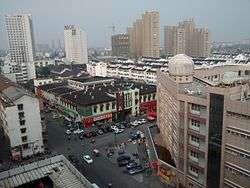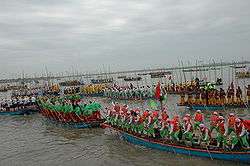Jiangyan District
| Jiangyan 姜堰区 | |
|---|---|
| District | |
 | |
 Jiangyan Location in Jiangsu | |
| Coordinates: 32°30′06″N 120°08′09″E / 32.5017°N 120.1358°ECoordinates: 32°30′06″N 120°08′09″E / 32.5017°N 120.1358°E[1] | |
| Country | People's Republic of China |
| Province | Jiangsu |
| Prefecture-level city | Taizhou |
| Area[2] | |
| • Total | 927.53 km2 (358.12 sq mi) |
| Population (2010)[3] | |
| • Total | 728,645 |
| • Density | 790/km2 (2,000/sq mi) |
| Time zone | China Standard (UTC+8) |
| Postal code | 2255XX |
Jiangyan District (simplified Chinese: 姜堰区; traditional Chinese: 姜堰區; pinyin: Jiāngyàn Qū) is one of three urban districts of the city of Taizhou, Jiangsu province, China, having been, until December 2012, a county-level city.[4] Jiangyan is noted for being the birthplace of the former General Secretary of the Communist Party of China Hu Jintao.
History

Formerly called Taixian or Taihsien (Traditional Chinese: 泰縣, Simplified Chinese: 泰县, pinyin: tāixīan), Jiangyan was a county by the end of the Western Han Dynasty. It has relics from the Zhou Dynasty and a Buddha statue from the Tang Dynasty. It was a town in the Qing Dynasty
Jiangyan has previously also been called Hailu (Chinese: 海陆), Wuling (Chinese: 吴陵), and Taizhou (Chinese: 泰州). In July 1994, the name was changed to Jiangyan and city status obtained.
The Qintong Boat Festival (Chinese: 溱潼会船) has a long history going back to the Ming Dynasty, and is growing in importance as a tourist destination in eastern China.
The Baima Temple (Chinese: 白马庙, meaning white horse temple) in Jiangyan (now in Taizhou) is the birthplace of the Navy of the People's Liberation Army.
The first Soviet base in northern Jiangsu was founded in Jiangyan by the No. 14 Red Army.
Jiangyan has been working to modernize the district through enhanced education and technology opportunities. Many technologies have been developed in Jiangyan, and more than 70 patents have been registered. Jiangyan has been among the "Top 100 most economically competitive counties in China" since 1995.
In 1990, Jiangyan was awarded the Global 500 Roll of Honor by the United Nations Environment Programme (UNEP) for its success in protecting the environment and increasing grain yield through wide use of marsh biogas ponds.
Administrative divisions
Jiangyan District is divided into 15 towns:[5]
Geography
Located in the center of Jiangsu province, Jiangyan is bordered on the east by Hai'an and Dongtai. To the west lie the districts of Hailing and Gaogang. Taixing is to the south and Xinghua to the north.
Transportation

The Nanjing-Jinjiang-Yancheng Highway passes runs north-south through the district, and National Highway 328 runs east-west. Water transportation is by the Yangzhou Canal, and the Zhonggan, Jiangyan-Qintong, and Jiangyan-Huangqiao rivers.
There is bus service to Jiangyan from Shanghai or Nanjing via National Highway 328 and the Nanjing-Jinjiang-Yancheng Highway.
Shanghai can be reached from Jiangyan in under three hours.
Tourism
Qintong Boat Festival

The Qintong Boat Festival is held every year in Qingming, around April 4–6. During the festival, boats from nearby villages and towns converge on Xique lake for a few days of celebration. Theatrical performances, dragon and lion dances, and other folk dances are held on the boats.
A highlight of the festival is the racing of boats using long poles instead of paddles.
The boat festival is an important tourist attraction and attracts foreign investment to the area.
Xique Lake
Xique Lake is located in Qintong, 15 kilometres (9.3 mi) north of Jiangyan, and makes up part of the Qintong Swamp.
Museums
Gao Ershi Museum is in Jiangyan.
Schools
There are 233 kindergartens, 280 primary schools, 50 middle schools, and 2 provincial special high schools. Jiangyan High School was named a model high school and promoted to be a provincial high school.
Notable people
Jiangyan is known for a number of notable people:
- General Chen Yi commanded the Battle of Huangqiao in Qujiang Tower, in downtown Jiangyan.
- Ming dynasty general Tang Shunzhi (唐顺之) fought the Japanese wokou in Jiangyan.
- Yue Fei (岳飞) and Wen Tianxiang (文天祥) were both stationed in Jiangyan to fight against the Jin and Mongol invaders during the Song dynasty.
- Wang Dong (王栋), one of the founders of the 'Taizhou clique' philosophy, taught in Jiangyan for decades in the Wanggong Temple ("王公祠"). The temple is now preserved as a museum.
- Liu Jingting (Chinese: 柳敬亭) was Master of Yangzhou Pingtan, a form of traditional Chinese opera.
- The artist Tang Zhique (唐志契), along with his brother Tang Zhiyi (唐志尹) and nephew Tang Riyin (唐日艮), the so-called 'Three Tangs', were from Jiangyan during the Ming dynasty.
- Huang Longshi (Chinese :黄龙士) was a Master of go in the Qing Dynasty.
- Gao Ershi (Chinese: 高二适) was a calligrapher in modern times.
- Lu Fubao (卢福保) was the consule of Taiwan.
- Hu Jintao(胡锦涛, the former General Secretary of the Communist Party, was born in Jiangyan.
References
- ↑ Google (2014-07-02). "Jiangyan" (Map). Google Maps. Google. Retrieved 2014-07-02.
- ↑ Taizhou Statistical Yearbook 2012/《泰州统计年鉴2012》.(Chinese) Accessed 9 July 2014.
- ↑ China 2010 Census County-by-county Statistics/《中国2010年人口普查分县资料》.(Chinese) Accessed 9 July 2014.
- ↑ "泰州姜堰撤市设区已获国务院和江苏省政府批准". People.com.cn. 4 January 2013. Retrieved 2013-01-07.
- ↑ 2011年统计用区划代码和城乡划分代码:姜堰市 (in Chinese). National Bureau of Statistics of the People's Republic of China. Retrieved 2013-01-07.
External links
- Official website of Jiangyan, Jiangsu
- Jiangyan English guide (Jiangsu.NET)
- Official website of Qintong Boat Festival